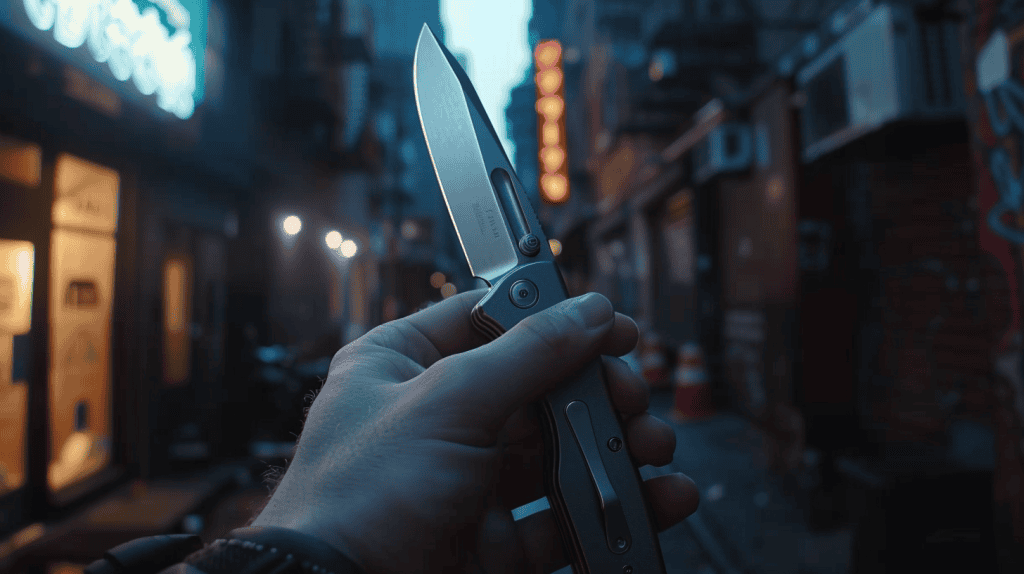Using a pocket knife for self-defense involves selecting the right knife, understanding laws, and mastering basic techniques. Choose a reliable knife, considering features like a spring-assisted mechanism and a secure grip. Comply with local regulations on blade size and prohibited features. Master a stable grip and stance, such as the hammer or saber grip, and practice controlled slicing motions rather than stabbing for better control. Focus on target areas like the eyes, throat, and groin to incapacitate an attacker quickly. Regular drills and situational awareness enhance your preparedness, ensuring effective defense in high-stress scenarios. Discover additional strategies to maximize your self-defense capabilities.
Key Takeaways
- Grip and Stance: Use a hammer or saber grip with a balanced stance to maintain control and stability during an encounter.
- Quick Deployment: Choose a knife with rapid deployment features, like spring-assisted opening, for immediate readiness in self-defense situations.
- Target Areas: To quickly neutralize a threat, focus on high-impact areas such as the eyes, throat, and groin.
- Legal Awareness: Understand and comply with local knife laws to avoid legal issues when carrying a self-defense knife.
Choosing the Right Knife
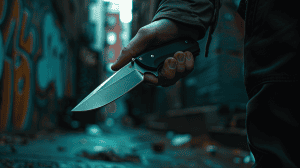 When choosing the right knife for self-defense, focus on a blade that’s reliable, easy to carry, and quick to deploy.
When choosing the right knife for self-defense, focus on a blade that’s reliable, easy to carry, and quick to deploy.
The materials and types of blades play essential roles in your decision. For knife materials, stainless steel and carbon steel are common choices. Stainless steel is corrosion-resistant and requires less maintenance, making it an excellent all-around option. Carbon steel, on the other hand, tends to hold a sharper edge longer but requires more care to prevent rust.
Blade types also matter considerably. A straight-edge blade is versatile and excellent for precision cuts, but a serrated edge can be more effective for cutting through tough materials like rope or fabric. Some knives offer a combination of both, giving you flexibility in various scenarios. A tanto blade, characterized by its robust tip, is ideal for piercing, while a drop point blade offers a more balanced option, suitable for both slicing and piercing.
Ultimately, the best knife for self-defense should fit comfortably in your hand and be easy to deploy quickly. Spring-assisted knives or those with thumb studs and flipper mechanisms often provide the fastest access, which can be vital in high-stress situations.
Understanding Legal Restrictions
When considering carrying a pocket knife for self-defense, it’s vital to understand the legal restrictions in your area.
Local carry laws vary considerably; knowing the knife size limits is essential to guarantee compliance.
Failure to adhere to these regulations can result in severe legal consequences, so always check your local laws first.
Local Carry Laws
Maneuvering local carry laws is essential to ascertain you’re legally protected when carrying a pocket knife for self-defense. Understanding local regulations can help avoid legal consequences for improper use or possession. Each state, and sometimes even cities within states, has rules for carrying knives. Familiarize yourself with these laws to ascertain compliance and avoid potential penalties.
| State | Legal Carry Status | Restrictions |
|---|---|---|
| California | Permitted | No switchblades over 2′ |
| Texas | Permitted | Schools and courthouses |
| New York | Restricted | Only folding knives are allowed |
To navigate these regulations, start by researching your state’s knife laws. Many states have online resources detailing what types of knives are permissible, where they can be carried, and any special conditions. For instance, some states may allow knives in public spaces but prohibit them in government buildings or schools.
Failure to comply with local laws can lead to severe legal consequences, including fines and, in some cases, imprisonment. By staying informed about and adhering to local regulations, you can carry your pocket knife confidently, knowing you’re within the law’s boundaries.
Knife Size Limits
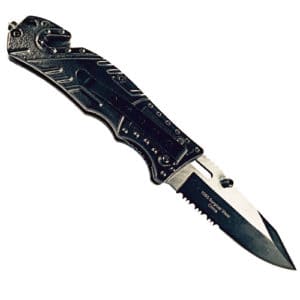 Knowing the legal size limits for pocket knives is vital to confirming your compliance with self-defense regulations. Different jurisdictions have varying laws regarding blade length, and it’s important to understand these before carrying a pocket knife. Many places impose restrictions, typically limiting blade length to three or four inches. Always check local laws to verify your tactical design fits within legal parameters.
Knowing the legal size limits for pocket knives is vital to confirming your compliance with self-defense regulations. Different jurisdictions have varying laws regarding blade length, and it’s important to understand these before carrying a pocket knife. Many places impose restrictions, typically limiting blade length to three or four inches. Always check local laws to verify your tactical design fits within legal parameters.
A pocket knife’s tactical design also plays a significant role in its legality. Some areas prohibit knives with specific features such as assisted opening mechanisms or double-edged blades. Even if your blade’s length is within legal limits, its design could still be illegal. Opt for a knife that meets size and design regulations to avoid legal complications.
Furthermore, research data indicates that law enforcement agencies frequently enforce these legal restrictions. Ignorance of the law won’t protect you from potential fines or confiscation of your knife. Consequently, it’s wise to consult local regulations or legal advisories specific to your area.
Basic Knife Handling
To effectively use a pocket knife for self-defense, you must master the basics of grip and stance, ensuring your hold is firm, and your posture is stable. Proper grip enhances control and safety, minimizing the risk of accidents.
Grip and Stance
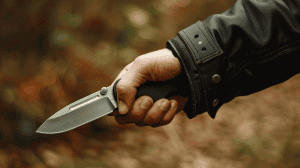 Proper grip and stance are essential for effectively using a pocket knife in self-defense. Mastering grip techniques guarantees you maintain control and reduce the risk of injury.
Proper grip and stance are essential for effectively using a pocket knife in self-defense. Mastering grip techniques guarantees you maintain control and reduce the risk of injury.
The most recommended grip is the hammer grip, in which your fingers wrap around the handle, and your thumb is placed on the blade’s spine. This grip provides stability and power.
Another adequate grip is the saber grip, which involves placing your thumb along the spine while your other fingers hold the handle. This grip offers precision and control, particularly for thrusting motions.
Stance adjustments are equally critical. A balanced stance provides a solid foundation and allows for quick movements.
Start by positioning your feet shoulder-width apart, with your dominant foot slightly back. Bend your knees slightly to lower your center of gravity, making it harder for an attacker to knock you off balance.
Keep your non-dominant hand up to protect your face, and your dominant hand, holding the knife, should be ready to defend or counter-attack.
Safety and Control
After establishing a solid grip and stance, master basic knife handling to guarantee safety and control during self-defense. Proper handling enhances your effectiveness and minimizes the risk of accidents. Understanding self-defense psychology is vital; it sharpens your awareness and helps you stay calm under pressure.
Key aspects of basic knife handling include maintaining a firm grip, being mindful of your knife’s orientation, and ensuring it’s always pointed away from you. Regular knife maintenance is equally important. A well-maintained knife reduces the risk of slippage and assures peak performance when needed.
| Basic Handling Tips | Key Points |
|---|---|
| Firm Grip | Enhances control and precision |
| Knife Orientation | Prevents accidental self-injury |
| Regular Maintenance | Assures reliability and sharpness |
Practicing these techniques regularly will build muscle memory, making them second nature during an actual confrontation. Remember, the goal isn’t to look intimidating but to handle your knife confidently and precisely. Mastering these fundamental skills creates a foundation for more advanced self-defense techniques. Stay committed to regular practice and maintenance, and you’ll be better prepared to protect yourself effectively.
Defensive Stance and Grip
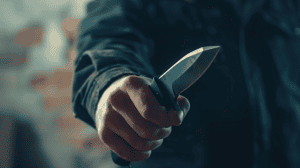
When holding a pocket knife for self-defense, position your feet shoulder-width apart to maintain balance and readiness. This defensive posture helps you stay grounded, making it harder for an attacker to knock you off balance. Bend your knees slightly, keeping your body relaxed but alert. Your non-dominant hand should be up, ready to block or deflect any incoming strikes.
Grip techniques are essential for controlling the knife effectively. Hold the knife firmly but not too tight, using a hammer grip where your fingers wrap around the handle and your thumb rests on top. This grip offers strength and stability, allowing you to maneuver the blade precisely. Alternatively, you can use a reverse grip, where the blade points downward, and your thumb rests on the butt of the handle. This grip can be helpful in close-quarters defense.
Maintain awareness of your surroundings, constantly scanning for potential threats. Keep your knife close to your body to protect it from being knocked out of your hand.
Practice these stances and grips regularly to build muscle memory, ensuring you can respond swiftly and effectively if you ever need to defend yourself.
Effective Cutting Techniques
To defend yourself effectively, focus on targeting vulnerable areas like the neck, wrists, and inner thighs with quick, controlled cuts. Mastering effective cutting techniques involves understanding cutting angles and utilizing slicing motions. This guarantees maximum impact while minimizing the risk of injuring yourself or losing control of the knife.
- Cutting Angles: Approach your target with precise cutting angles. A diagonal angle can increase the effectiveness of your cut by following the natural muscle and tissue direction, causing more damage and swiftly deterring your attacker.
- Slicing Motions: Utilize slicing motions rather than stabbing. Slicing requires less force and allows for continuous, flowing movements, reducing the chance of your knife getting stuck in the assailant.
- Controlled Cuts: Always aim for controlled cuts. Practicing in a safe environment can help you maintain your composure and execute cuts smoothly under pressure. Controlled cuts guarantee accuracy and help you avoid overextending, which can expose you to counterattacks.
Incorporate these techniques into your training regimen. Understanding the mechanics of cutting angles and slicing motions enhances your defensive capabilities and builds confidence. Proper technique guarantees your actions are effective and safe during a confrontation.
Target Areas for Self-Defense
Prioritizing specific target areas can significantly increase your chances of successfully defending yourself with a pocket knife. Focusing on vulnerable points is essential, as it can quickly incapacitate an attacker, allowing you to escape. Recognizing the right areas and employing effective self-defense tactics can significantly affect a confrontational situation.
| Target Area | Effectiveness Level |
|---|---|
| Eyes | High |
| Throat | High |
| Groin | Medium |
| Abdomen | Medium |
| Arms | Low |
| Legs | Low |
Targeting the eyes can cause immediate pain and disorientation, allowing you time to flee. The throat is another vital area; a well-placed strike can restrict breathing and neutralize the threat. The groin, although not as incapacitating as the first two, can still cause significant pain and shock.
The abdomen and arms are less practical but still useful. Striking the abdomen can wind an assailant while targeting the arms can reduce their ability to hold or use a weapon. Finally, legs, though being the least effective, can destabilize an attacker by affecting their mobility. Focusing on these vulnerable points and mastering self-defense tactics can be key to your safety.
Situational Awareness
 Understanding situational awareness is essential for effectively using a pocket knife for self-defense.
Understanding situational awareness is essential for effectively using a pocket knife for self-defense.
Situational awareness involves being conscious of your surroundings and potential threats. It starts with threat assessment, where you evaluate the people and objects around you to identify any immediate dangers.
To enhance your situational awareness, follow these three steps:
- Environmental Scanning: Continuously monitor your environment by looking around and noting exits, potential hiding spots, and objects that could be used as weapons. This helps you stay prepared and avoid being caught off guard.
- Recognize Behavioral Cues: Pay attention to the body language and behavior of those nearby. Signs of aggression or nervousness can indicate a potential threat. Trust your instincts if someone’s behavior feels off.
- Maintain a Safe Distance: Establish and maintain a physical buffer zone between yourself and others, especially in crowded or unfamiliar places. This distance gives you more time to react if a threat arises.
Regular Practice and Training
Consistently practicing and training with your pocket knife guarantees you’re prepared to use it effectively in self-defense situations. Regular training familiarizes you with your knife’s weight, balance, and operation, making it second nature to handle. Incorporating practice drills into your routine helps simulate real-world self-defense scenarios, enhancing your reaction time and precision.
Start with basic drills, such as drawing the knife quickly and safely from your pocket or sheath, and progress to more complex exercises, like defending against various angles of attack. According to self-defense experts, practicing these drills regularly builds muscle memory, which is vital in high-stress situations. Research indicates that repeated practice can significantly improve your ability to perform under pressure.
Additionally, consider attending self-defense classes that focus on knife training. These classes often provide valuable insights into effective techniques, strategies, and opportunities to practice with others. Controlled sparring sessions can offer a realistic sense of timing and distance management, which are vital elements in a self-defense scenario.


